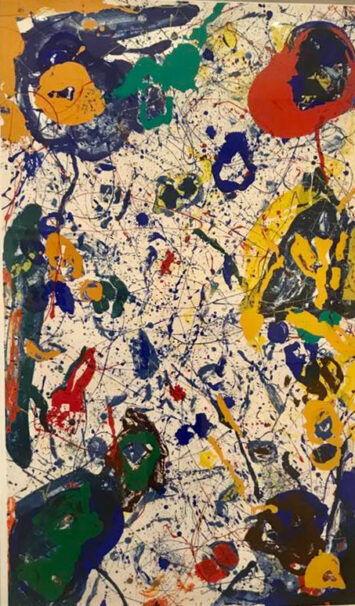
Though his last productive years were spent in a Santa Monica studio, art fanciers with a taste for the color-laden Sam Francis (1923-1994) paintings had to search out isolated canvases at a couple of local museum installations. With “Sam Francis and Japan: Emptiness Overflowing” (through July 16 at LACMA, the Los Angeles County Museum of Art), they’ll have a rare chance to submerge themselves in his teeming pools and colorful explosions in the company of work by some of the Japanese artists who influenced him, and whom he subsequently touched.

Abstract Expressionism, that kinetic non-representational painting style, exploded out of the New York art world, beginning in the late 1940s. Vibrant canvases by Jackson Pollock, Franz Kline, Willem De Kooning and others roiled Gotham’s gallery culture. The hard-drinking ethos of those painters and their sometimes violent derring-do generated myth which almost overshadowed the work. AE was the perfect artistic complement to post-World War II nuclear loathing, psychoanalysis, sick humor, the Beat Generation, and all things bohemian.
Francis, an affable Californian, first took the AE style abroad. He relocated to Paris in 1950 and carried with him the Continent’s first taste of authentic action painting. His work, though kinetic and bold, differed strikingly from that of his East Coast brethren. Francis trafficked in bright colors and let the white, negative spaces speak almost as loudly as his intriguing biomorphic shapes. He also courted a floating quality that found antecedent in Monet’s Impressionist waterlilies, an oeuvre he was able to study firsthand.
On the California Coast, Francis came into contact with practitioners of traditional sumi-e painting, that elegant and economical cocktail of sharply-delineated brush strokes and sublime diffused washes. The otherwise insular avant-garde Gutai collective in Japan, saw Francis as a kindred soul, and began a long-running exchange of trans-Pacific works with him. Francis exhibited in Tokyo and subsequently moved to Japan in 1957, when he executed a mural commission at the Sogetsu school of flower arrangement. Japanese critic Yomekura Mamoru coined the phrase “an emptiness overflowing” to describe the Francis esthetic.

Five LACMA galleries focus on different spokes in the Francis wheel. The juxtaposition of works by Francis and the Japanese painters is not only effective, it’s instructive.
From exquisite calligraphy to compositions that hug the corners and edges of the picture plane, the Francis modus operandi becomes clearer. It’s to LACMA’s credit that most of the 80-plus pieces in the show are from the museum’s own collection.
Exhilaration, through bright colors and lively organic shapes, abound in the Francis paintings and prints. But as alive as the images are, they also beg contemplation. Like those of his Japanese counterparts, Francis’s work often impart an air of serenity on one hand, and a teeming hive of biological activity on the other.
Sit with any of them at length, and see if you’re not drawn into a world that he’s teased with a beckoning sliver or a cobalt blue amoeba. It’s the special visual gemütlichkeit of a California original.
image credits: courtesy lacma los angeles county museum of art
Kirk Silsbee publishes promiscuously on jazz and culture.
Sam Francis and Japan: Emptiness Overflowing | LACMA | thru July 16

Excellent article and photos. Very well done !